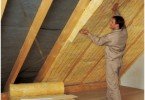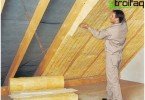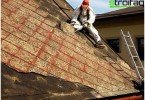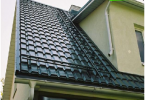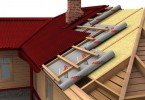Transparent slate
The most common roofing material is slate. There is a simple explanation for this – this material has a lot of advantages. These include cost-effectiveness, practicality, a number of technical characteristics, thanks to which slate is rightfully considered one of the best roofing for cottages, country houses, garages and other outbuildings. And now, in addition to the traditional slate, a new, modern type of material has come – transparent slate, which is used to create a light-transmitting roof. With it you can implement the most interesting design decisions..
Content
- Advantages of transparent slate
- Where transparent slate is used?
- Features of the installation of a transparent roof
- Other types of transparent slate
- Acrylic slate
- Polycarbonate Roofing
- A variety of plastic slate
Advantages of transparent slate
Transparent slate differs from the usual one in almost everything, they have in common, perhaps, only the shape of the sheets and the name. The properties of these two materials are different. Transparent slate is made by extrusion from homogeneous polymers. This roofing material is based on polyvinyl chloride, acrylic, and fiberglass..
Transparent PVC slate perfectly transmits light, but at the same time it is a sealed coating that reliably protects the house from winds, rain and low temperatures. The material is plastic, so it can be used to create various complex shapes of the roof – arches, domes, etc. Transparent PVC slate has many advantages, such as, for example:
- high light transmission;
- high degree of flexibility;
- elasticity;
- resistance to atmospheric agents;
- resistance to UV rays: does not fade in the sun, does not pass harmful solar radiation;
- sufficiently high strength: it does not collapse under the influence of hail, withstands strong winds and snow loads;
- light weight;
- excellent soundproof properties;
- environmental friendliness – the material is resistant to chemicals (sea wind, acid rain, bacteria, etc.);
- low flammability – in case of fire it does not support combustion;
- ease of installation;
- profitability: sheets can be overlapped and bent without using special fastening systems;
- durability – not subject to icing and corrosion, can last up to 30 years;
- beautiful appearance: a rich color palette allows you to create, if desired, even a mosaic.
But there is a polymer slate and a couple of disadvantages:
- firstly, you can’t walk on it – such a roof will not withstand a lot of weight;
- secondly, the sheets change their size under the influence of temperature to a greater extent than the structural elements to which they are attached, and this must be taken into account during installation. In addition, this material withstands temperatures from minus 20 to plus 50 degrees during operation, and this is not enough in cold winters and very hot summers..
Where transparent slate is used?
Although this roofing material is quite unusual, it allows you to create attractive roof structures, and therefore is widespread. It is used:
- For the construction of the roof of buildings for various purposes.
- For roofing arched structures – in warehouses or hangars.
- During the construction of arbors, outbuildings, canopies, hedges.
- For roofing in greenhouses and greenhouses.
- For the manufacture of canopies over summer playgrounds, sports facilities, cafes.
- To cover the roofs of indoor pools, pavilions of public transport stops, car parks.
- For the installation of interior elements – interior partitions, showers, light lamps.
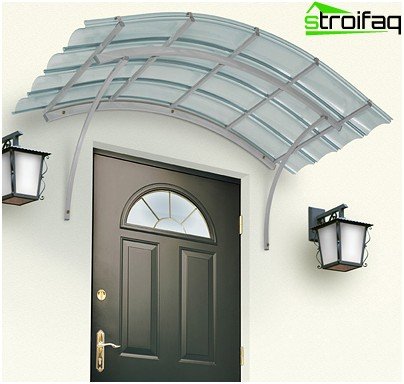
Canopy made of transparent slate – easy to install, durable and original
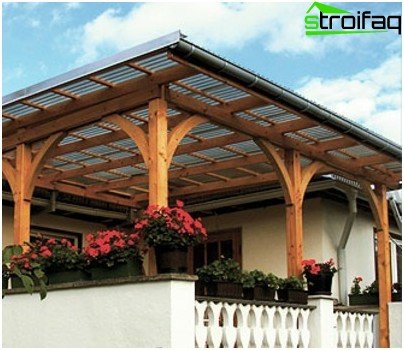
Summer terrace with a translucent roof looks attractive
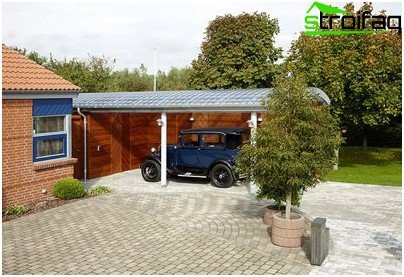
Transparent slate is used to cover the roofs of parking lots
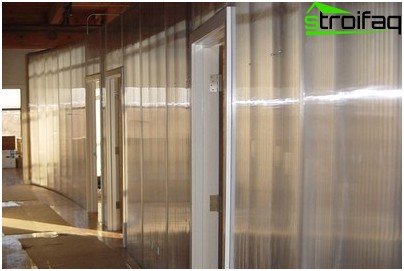
Use of transparent slate as an element of the interior – interior partitions
According to statistics, 75% of the total amount of transparent slate sold is used in individual construction. The rest is industrial facilities and other structures. The level of strength, heat and soundproofing properties of the material allow it to be used only for those structures for which the roof quality does not have special requirements.
Features of the installation of a transparent roof
The operation of a transparent roof depends directly on its competent installation.
When erecting a light-transmitting roof, certain conditions prescribed for this type of coating must be observed:
- to reduce the load on the material, the angle of the roof slope should be more than 8 degrees;
- the radius of the created arch joints should be at least 2.5 meters;
- the sheets are laid on the crate by the method of partial mutual overlapping to a width of about 20 cm;
- it is preferable to use a wooden crate treated with an antiseptic, but if a metal crate is used, it is covered with aluminum foil or painted with white paint to avoid overheating of the metal;
- sheets of adjacent rows are displaced by half the length of the sheet relative to each other; The offset will eliminate four-layer overlapping angles;
- slate sheets are laid perpendicular to the direction of the battens, their fastening is carried out from the bottom up;
- fastening with screws for fastening is made through 3 waves, and at the eaves of the ridge – after 2 waves;
- Before screwing the screws into the slate sheets, holes with a diameter of 3 mm are made larger than the diameter of the screw. The holes are drilled at least 40 millimeters from the edge of the sheet;
- in places where the material adjoins the wall or chimney, a gap of three millimeters is left;
- approximately 20 screws are used to secure one sheet;
Cutting, drilling and sawing transparent slate is recommended using a circular saw, a jigsaw, and a hacksaw with small teeth.
It’s important to know! You can’t walk on a transparent roof, to move on it you need to use a wide board three times as long as the sheet.
Other types of transparent slate
Acrylic slate
Acrylic is colorless, characterized by good elasticity, withstands heavy loads. It is better known as plexiglass. Acrylic sheets are used to create a light roof. The life of this type of transparent slate is 10 years..
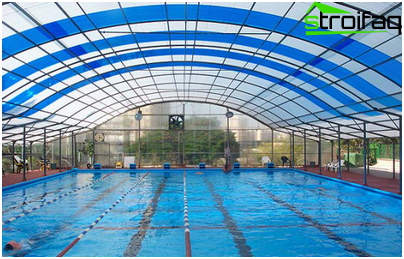
Transparent acrylic slate transmits ultraviolet rays well, it is suitable for roofing over pools
The channels of which the sheets consist are filled with air and separated from each other by rigid ribs. Having a light weight, the material is durable and has good thermal insulation properties. Acrylic slate transmits UV rays well, which is why it is used to equip solarium roofs and swimming pools. But interior items under such a roof are subject to burnout.
Polycarbonate Roofing
Transparent slate, which is made of polycarbonate, has more significant qualities. Its service life is 15 years, so the demand for it is greater than for acrylic. In addition to excellent transparency and strength properties, such a slate practically does not burn, tolerates the effects of aggressive chemicals, has significant resistance to wind loads.
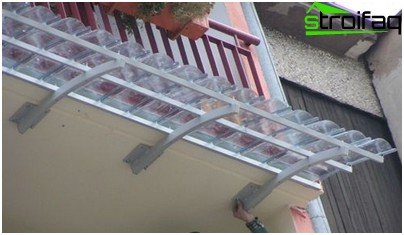
This cute transparent visor on the balcony will surely attract the eyes of passers-by.
A variety of plastic slate
The production of plastic slate is carried out by extrusion. The granules are heated in the installation until they turn into molten plastic, which is subsequently drawn through an extruder. In the process of drawing, the plastic cools, acquiring the necessary strength, the extruder gives it the width and shape of the sheet. At the end of the processing line, cutting determines the length of the sheet..
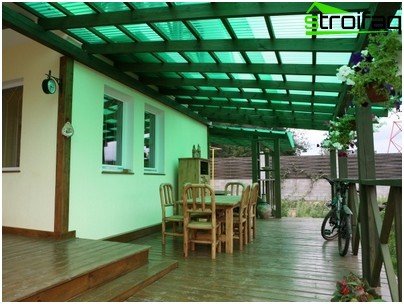
Colored plastic slate creates amazing lighting effects, makes the room bright and comfortable
In shape, the plastic slate is flat, wavy and trapezoidal, in color – white or color. It can also be plain or fiberglass reinforced. Fiberglass slate is made of polymeric material reinforced with fiberglass. This heat-resistant material can be used in a wider temperature range: from -40 degrees to + 140 degrees Celsius, therefore it is considered more reliable and durable. Fiberglass includes the qualities of metal and polymer, that is, it has great strength with a small specific gravity. Thanks to fiberglass reinforcement, this type of slate can easily withstand strong winds, hail and snow, does not warp. No pollution is collected on its surface, so it always maintains a well-groomed and attractive appearance. A variety of colors create unique lighting effects. Such a roof will emphasize fashionable architectural trends..
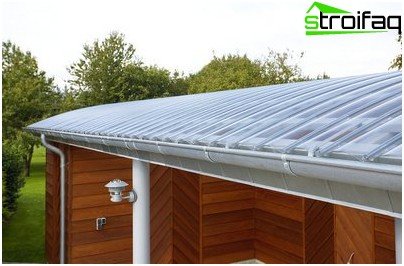
A transparent roof gives the building its own personality.
A distinctive feature of fiberglass slate is that it transmits sunlight in the spectrum required for the biological activity of plants. Therefore, many greenhouses and greenhouses are covered with this material..
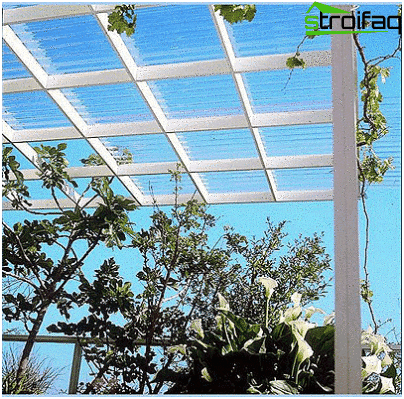
Fiberglass slate is favorable for the biological activity of plants – it transmits the sun’s rays of the corresponding spectrum
The existing rolled modification of fiberglass slate simplifies the installation of the roof, and the absence of an overlap reduces the coating consumption. The canvas in rolls has a length of 20 meters with a width of 1.5 or 2 m.
You need to know! When choosing material for a transparent roof device, it is imperative to take into account the climatic conditions of the region where the facility is being built. In heavy snowfalls, supporting structures should be strengthened, and in extreme heat, protection against overheating should be taken into account. Therefore, the installation of a light-transmitting roof must be carried out in accordance with the project, observing technological standards.
Transparent slate is affordable and quality, attractive to give the building a personality, and ease of installation makes it indispensable for widespread use, both in municipal construction and among private developers.


